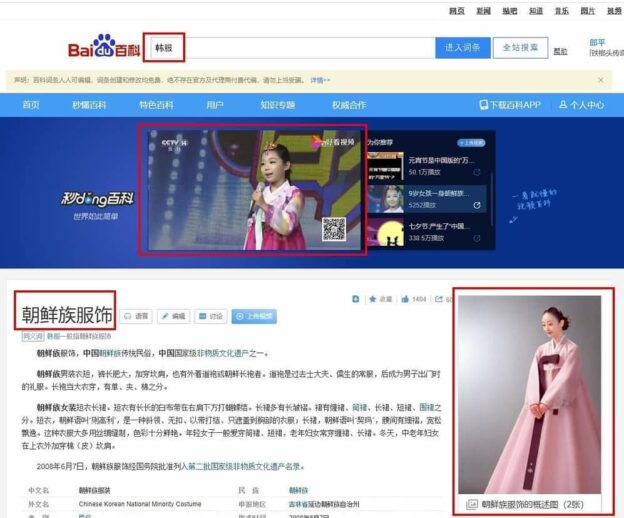
In June 2008, the Chinese government officially registered Hanbok as a “national intangible cultural heritage” under the pretext of preserving the culture of the Joseonjok, a Korean ethnic minority in China. This move has sparked significant controversy, as the government promotes Hanbok as a traditional costume of the Joseonjok, an ethnic group within China, while obscuring its true Korean heritage.
Currently, when users search for “Hanbok” (韩服) on Baidu, China’s largest search engine and a major platform for spreading information, they are redirected to a page that describes Hanbok as “Joseonjok attire.” This distortion is further propagated on Baidu Baike, the platform’s online encyclopedia, where Hanbok is listed under the category of “Joseonjok clothing” and falsely stated to have been registered as a part of China’s intangible cultural heritage. Notably, images of popular Korean celebrities, such as Kim Tae-hee, wearing Hanbok are presented within the context of this erroneous description.
The most concerning issue is the potential for this misrepresentation to lead to the global misconception that Hanbok is a costume of the Joseonjok, rather than a traditional Korean garment. This mischaracterization not only erodes Korea’s cultural identity but also risks legitimizing China’s claim over Hanbok as part of its cultural heritage.
Among the false information highlighted on Baidu Baike is the claim that Hanbok was registered as “Joseonjok clothing” in June 2008, under the listing of China’s national intangible cultural heritage. The description also misrepresents the Joseonjok costume as “Joseonjok court attire” and includes photographs of Korean celebrities, such as Kim Tae-hee and Lee Wan, wearing Hanbok. These images, alongside the inaccurate description, further blur the cultural lines between China and Korea.
This issue is not limited to Baidu Baike. On YouTube, a video platform banned within China but accessible globally, Hanbok continues to be promoted as the traditional attire of the Joseonjok. A notable example is a 2019 video produced by Yanbian University in celebration of the 70th anniversary of the founding of the People’s Republic of China. The video features a young girl dressed in Hanbok singing “I and My Motherland” (我和我的祖国), followed by a group of individuals in Hanbok singing in both Chinese and Joseonjok (the language of the Korean-Chinese minority).
In addition, various videos produced by Chinese media continue to emphasize Hanbok as the traditional clothing of the Joseonjok, further consolidating the notion that Hanbok belongs to China’s cultural heritage. One such example is from the variety show “This! Is Street Dance 3” (这! 就是街舞3), where the judge, EXO’s Lay (a member of the popular Korean-Chinese boy band), remarks, “The Joseonjok’s Arirang and fan dance were well-expressed with hip-hop.”
The ongoing distortion of Hanbok’s origin, as well as the misrepresentation of Korea’s cultural heritage, highlights the importance of raising global awareness and addressing these inaccuracies. The Korean government and cultural institutions must continue to advocate for the rightful recognition of Hanbok as a Korean cultural treasure and prevent its hijacking by China.